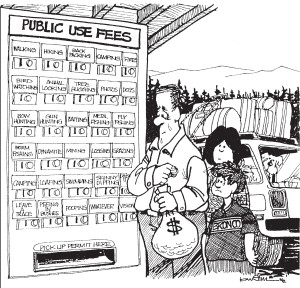 Intended to facilitate public involvement in recreation fee decisions, RRACs have instead obstructed public involvement and acted as rubber-stamps for the agencies.
Intended to facilitate public involvement in recreation fee decisions, RRACs have instead obstructed public involvement and acted as rubber-stamps for the agencies.
Since 2005, all new fees and fee increases for Forest Service and Bureau of Land Management lands are required to be reviewed by a Recreation Resource Advisory Committee (RRAC). The first RRACs began to come on line in late 2007 and early 2008. The members of the RRACs are selected by the agencies, supposedly to represent various categories of public lands users. Generally they are chosen from among groups that there is already a close relationship with – groups that are beholden to the agencies in various ways – so members tend to approve pretty much everything.
RRAC meetings are required to be open to the public, but many of them are announced only in the Federal Register, which makes it difficult for the public to find out about them. Agendas and minutes can also be difficult to obtain. You can view a map of how the RRACs are organized and link to specific RRAC websites here.
The law says that the agencies may use already-existing committees as RRACs or they can charter new ones. The Forest Service and BLM entered an interagency agreement that calls for a mix of both. The Forest Service chartered five new committees for California, Washington/Oregon, Colorado, the Northeast states and the Southeast states, to review both USFS and BLM fee proposals. Elsewhere the existing BLM Resource Advisory Councils were given authority over both BLM and USFS proposals.
Since first being established in 2007-2008 the Forest Service committees have struggled to maintain sufficient members to raise a quorum, and as of 2015 have not been able to meet for such a long time that all the members’ terms have expired. The BLM committees are active and meet regularly, so most new and increased fees in recent years have been in states covered by BLM RRACs: Montana, Idaho, Nevada, Utah, Arizona, and New Mexico,
The law specifies that a Recreation Resource Advisory Committee can not recommend a fee proposal without documentation of general public support, but silence, or even just a few supportive comments (often solicited by agency managers from among their friends) have generally proven sufficient to satisfy the committee members.
The process is deeply flawed and not at all effective at gauging public support. The WSNFC has recommended to Congress that any reform or replacement of FLREA should eliminate the RRACs, and we have suggested several more effective methods. For a chart of pending and recent Forest Service proposals for new and increased fees, click HERE. Updated October, 2016.
New development, November 2016. The Forest Service has used a clause in FLREA that allows the governor of a state to opt-out of the RRAC process altogether to eliminate the Colorado RRAC. For several years the FS has been unable to either attract applicants for the Colorado committee or to convince any other statewide advisory group to take on the responsibility. So they approached Governor John Hickenlooper with a cockamamie idea that not having an RRAC at all would somehow improve public involvement. They got him to request a waiver, which was granted by the Secretary of Agriculture. Read the Denver Post story here: 2016_11_10_colorado_sheds_citizen_review_of_fees
With this get-out-of-jail-free tactic having succeeded in Colorado, look for more of this in other states.
Read our report “The Fix Is In” here.
More Examples:
A Yes Vote Without A Quorum
Pacific NW Committee Approves 72 Fees Over Public Objection
San Juan River Access Fee Approved Despite Public Opposition
BLM Committee Deceived Into Approving Fee At San Joaquin River Gorge
